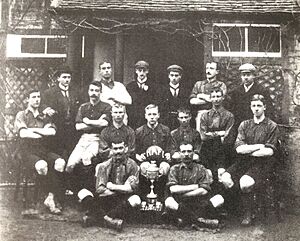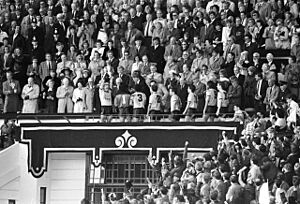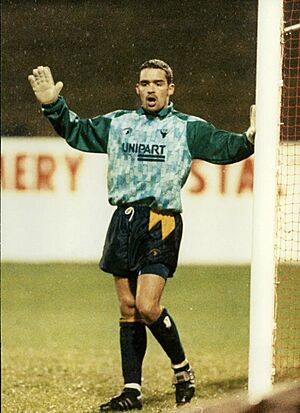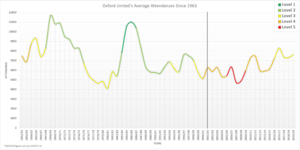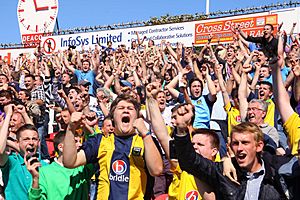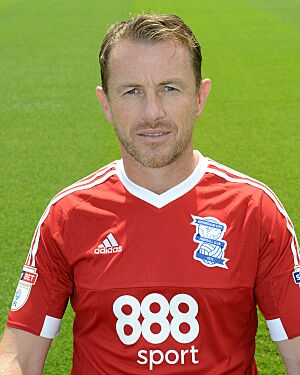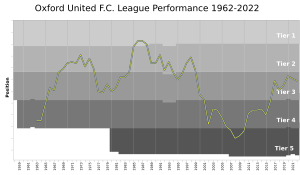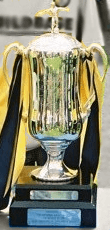Oxford United F.C. facts for kids
 |
||||
| Full name | Oxford United Football Club | |||
|---|---|---|---|---|
| Nickname(s) |
|
|||
| Founded | 27 October 1893 (as Headington F.C.) |
|||
| Ground | Kassam Stadium | |||
| Capacity | 12,573 | |||
| Co-owner | Erick Thohir and Anindya Bakrie | |||
| Chairman | Grant Ferguson | |||
| Head coach | Gary Rowett | |||
| League | League One | |||
| 2018–19 | League One, 12th of 24 | |||
|
||||
Oxford United Football Club is a professional football team from Oxford, England. They are often called "The U's" or "Yellows." The club plays in the EFL Championship, which is the second-highest league in English football.
Oxford United started as Headington Football Club in 1893. They changed their name to Oxford United in 1960. Since 2001, their home games have been played at the Kassam Stadium. Before that, they played at the Manor Ground.
The club joined the Football League in 1962. They won the Southern Football League twice before joining. They reached the Second Division in 1968. After a tough period, they earned two promotions in a row between 1984 and 1986. This took them to the top league, the First Division.
In 1986, Oxford United won the League Cup. This was a huge achievement for the club. However, they could not play in the UEFA Cup because English clubs were banned from European competitions at the time.
After being relegated from the top league in 1988, the club faced a long decline. In 2006, they were relegated to the Football Conference, a non-league division. They were the first team to win a major trophy and then drop out of the Football League.
But Oxford United fought back! After four seasons, they returned to EFL League Two in 2010 through the play-offs. Six seasons later, in 2016, they were promoted to EFL League One. In 2024, they earned another promotion to the EFL Championship through the play-offs.
Some famous players for Oxford United include Ron Atkinson, who played the most games (560). John Shuker played the most Football League games (478). Ron's brother, Graham Atkinson, scored the most goals (107). Many players have also played for their national teams while at Oxford.
The team's main colours are yellow shirts, with navy shorts and socks. Their badge shows an ox. This symbol represents the city of Oxford, which was once a market town for cattle near a river crossing. Oxford United has a big rivalry with Swindon Town. Their games are known as the A420 derby.
Contents
Club History
Early Years: Headington F.C. (1893–1960)
Oxford United started on October 27, 1893. It was first called Headington Football Club. A local doctor, Robert Hitchings, and a vicar, Revd John Scott-Tucker, helped create the club. They wanted cricketers to stay fit during winter.
In 1911, the club added "United" to its name after joining with Headington Quarry. Their first game was against Cowley Barracks. For many years, Headington had no fixed home ground. In 1913, they bought Wootten's Field, but had to move in 1920.
In 1925, they found a permanent home at the Manor Ground. This place was used for cricket in summer and football in winter. In 1899, Headington United joined the Oxfordshire District League. They later moved to the Oxon Senior League in 1921.
One early game saw a player named P. Drewitt score 8 goals in a 9–0 win. This is still a club record! The team played their first FA Cup game in 1931, losing 8–2. In 1947, they spent two seasons in the Spartan League. Around this time, the cricket team moved to a new place.
Becoming Professional (1948–1960)
Headington United thought about becoming a professional club in 1948. They applied to join a new league. In 1949, they became professional and joined the Southern League. They hired Harry Thompson as their manager.
In 1950, Headington United was the first professional club in Britain to install floodlights. They used them for a game on December 18 against Banbury Spencer. The team first wore orange and blue shirts. But for the 1957–58 season, they changed to yellow home shirts.
Oxford United and League Success (1960–1985)
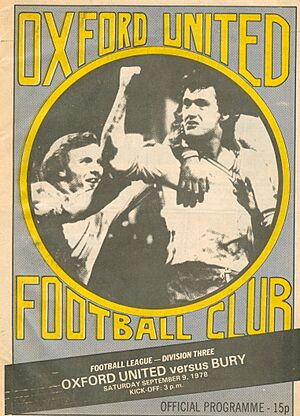
In 1960, Headington United changed its name to Oxford United. This was to make the club more well-known. Two years later, in 1962, they won the Southern League title for the second time in a row. This win helped them get elected into the Football League Fourth Division. They took the spot left by Accrington Stanley, who had gone bankrupt.
In 1965, Oxford United was promoted to the Third Division. A year before that, they made history. They became the first Fourth Division club to reach the sixth round of the FA Cup. In 1968, they won the Third Division title. This was only their sixth season in the Football League. However, in 1976, they were relegated from the Second Division.

In 1982, Oxford United faced big money problems. They were almost shut down. But a businessman named Robert Maxwell took over the club and saved it. In 1983, Maxwell suggested merging Oxford United with Reading. The new club would be called Thames Valley Royals. Fans from both clubs protested, and the merger was stopped.
Under manager Jim Smith, Oxford won the Third Division title in 1984. The next year, they won the Second Division title too! This meant Oxford United would play in the top league, the First Division, in the 1985–86 season. This was just 23 years after joining the Football League. Jim Smith then left, and Maurice Evans became the new manager.
Top League and Cup Glory (1985–1994)
In the 1985–86 season, Oxford United finished 18th in the First Division. They avoided relegation on the very last day by beating Arsenal 3–0. They also won the Football League Cup, then called the Milk Cup.
As cup winners, Oxford should have played in the UEFA Cup. But English teams were banned from European competitions because of the Heysel Stadium disaster the year before. In the final, held at Wembley Stadium on April 20, 1986, Oxford beat Queens Park Rangers 3–0. Goals came from Trevor Hebberd, Ray Houghton, and Jeremy Charles. It was a truly special day for the club.
The 1986–87 season saw Oxford United stay in the First Division. However, key players like John Aldridge were sold. Robert Maxwell left as chairman in 1987. The team struggled, and manager Maurice Evans was sacked in March 1988. Oxford was relegated to the Second Division.
After more changes in management and ownership, Brian Horton became manager. He kept the team in the middle of the table for a few years. In 1993, Horton left for Manchester City. Oxford was relegated to Division Two at the end of the 1993–94 season.
Financial Struggles and League Drops (1994–2001)
Denis Smith returned as manager and brought in new players. In the 1995–96 season, Oxford finished second and were promoted to Division One.
In 1995, the club planned a new 16,000-seat stadium at Minchery Farm. This was to replace the old Manor Ground. But construction stopped because the building company wasn't paid.
In 1998, the club faced serious money problems. A group of fans formed "Fighting for Oxford United's Life" (FOUL) to help. In April 1999, Firoz Kassam bought most of the club for £1. He also took on the club's large debt. Kassam worked to finish the new stadium.
The team's performance got worse. In 2001, Oxford was relegated to the Third Division. This was their lowest league position in 35 years. They conceded 100 goals and lost 33 league games, which was one of the highest numbers of defeats ever.
New Stadium and Conference Years (2001–2010)
Oxford United started the 2001–02 season with a new manager and a new home. The move to the Kassam Stadium was finally complete. Mark Wright was the new manager, but he resigned quickly. Ian Atkins took over, and the team finished 21st, their lowest position yet.
In 2004, Ian Atkins was sacked. Ramón Díaz from Argentina became the first non-British manager. He brought in some South American players. After him, Brian Talbot took charge but was also sacked in 2006.
On March 21, 2006, Firoz Kassam sold the club to Nick Merry. Merry brought back former manager Jim Smith. Despite new players, Oxford was relegated to the Conference National at the end of the 2005–06 season. After 44 years, they were out of the Football League. They were the first team to win a major trophy and then drop out of the league.

Jim Smith stayed as manager. In the 2006–07 season, Oxford finished second in the Conference. They reached the play-offs but lost in the semi-final. In 2007, Jim Smith resigned, and Darren Patterson became manager.
In 2008, Kelvin Thomas replaced Nick Merry as chairman. Patterson was sacked, and Chris Wilder became manager. Wilder led the team to a strong finish in the 2008–09 season.

In the 2009–10 season, Oxford finished third in the Conference. They won their play-off semi-final against Rushden & Diamonds. Then, they played York City in the play-off final at Wembley on May 16, 2010. Oxford won 3–1, returning to the Football League! Over 33,000 Oxford fans were there.
Back in the Football League (2010–Present)
Oxford's first game back in the Football League was a 0–0 draw. Their first win was a 4–0 victory against Morecambe, with James Constable scoring three goals. They finished 12th in their first season back.
The team often challenged for play-off spots in the following seasons. In 2012, they beat rivals Swindon Town twice in one season for the first time since 1974. Chairman Kelvin Thomas stepped down in 2012, and Ian Lenagan became the new owner.
Manager Chris Wilder left in 2014. After a few temporary managers, Michael Appleton took over in July 2014. In his second season, 2015–16, Oxford earned promotion to League One by finishing second. They also reached the final of the League Trophy at Wembley, but lost 3–2.
In 2017, Appleton left, and Pep Clotet became manager. He was sacked in January 2018. In February 2018, Thai businessman Sumrith "Tiger" Thanakarnjanasuth bought the club. Karl Robinson was appointed manager in March 2018 and helped the club stay in League One.
In the 2019–20 season, which was affected by the COVID-19 pandemic, Oxford finished fourth. They reached the play-off final but lost 2–1 to Wycombe Wanderers at Wembley.
Oxford made the play-offs again in the 2020–21 season but lost to Blackpool. In the 2021–22 season, they were one of the top-scoring teams. During this time, Indonesian businessmen Erick Thohir and Anindya Bakrie took control of the club. Grant Ferguson became the new chairman.
In the 2023–24 season, Oxford United achieved promotion to the Championship! They beat Bolton Wanderers 2–0 in the play-off final. This marked their return to the second tier of English football after 25 years. On December 15, 2024, Des Buckingham was sacked as manager and was replaced by Gary Rowett.
Club Colours and Badge

The Oxford United badge features an ox. This animal represents the city of Oxford itself. The city's name comes from "ox" and "ford," meaning a place where oxen could cross a river. The badge design has changed many times over the years.
In 1979, a zoologist named Desmond Morris, who was a club director, designed the current ox-head logo. It was inspired by ancient bull's heads. The design has been updated several times, but the ox head remains the main symbol. In 2018, the badge was redesigned for the club's 125th anniversary, bringing back a shield shape around the ox head.
In 2008, a bronze statue of an ox was placed outside the Kassam Stadium. It was later covered in pink paint by vandals. The club used this event to raise money for a breast cancer charity.
When the club was called Headington United, they wore orange and blue striped shirts. They changed to yellow home shirts in the 1957–58 season. Since the early 1990s, the main kit has been a yellow shirt with navy shorts and socks. The club has used many different away kit colours over the years.
The first sponsor on the shirt was a local newspaper in 1982. Since then, many companies have sponsored the shirts, including Unipart, Buildbase, Bridle Insurance, Liontrust, and Singha. Since August 2020, the Tourism Authority of Thailand has been a main sponsor, using the "Amazing Thailand" brand.
Kit Suppliers and Shirt Sponsors
| Period | Kit manufacturer | Shirt sponsor |
|---|---|---|
| 1973–1977 | Umbro | — |
| 1977–1980 | Admiral Sportswear | |
| 1980–1982 | Adidas | |
| 1982 | Sunday Journal | |
| 1982–1985 | Spall | BPCC |
| 1985–1989 | Umbro | Wang Computers |
| 1989–1990 | Scoreline | — |
| 1990–1991 | Pergamon Press | |
| 1991–1994 | Matchwinner | Unipart |
| 1994–1996 | Manor Leisure | |
| 1996–1998 | Own Brand | |
| 1998–2000 | New Balance | |
| 2000–2001 | Domino | |
| 2001–2006 | TFG Sports | Buildbase |
| 2006–2009 | Carlotti | |
| 2009–2010 | Nike | |
| 2010–2013 | Bridle Insurance | |
| 2013–2014 | Animalates | |
| 2014–2015 | Avec | Black 'n' Rounds |
| 2015–2016 | — | Liontrust |
| 2016–2018 | Starter | |
| 2018–2020 | Puma | Singha |
| 2020–2021 | Visit Thailand | |
| 2021–2022 | EB Charging | |
| 2022–2024 | Macron | Bangkok Glass |
| 2024– | Baxi |
Stadium History
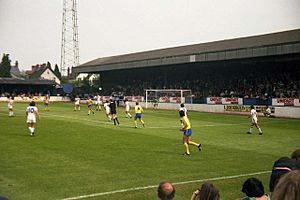
Oxford United did not have a regular home ground until 1913. They played at several different fields in Headington. In 1913, they bought Wootten's Field, but it was redeveloped.
From 1925 to 2001, the club played at the Manor Ground. This ground was shared with Headington Cricket Club until 1949. The Manor Ground could hold 9,500 people when it closed. However, it once hosted a record crowd of 22,750 fans in 1964 for an FA Cup match.
In the 1990s, new rules meant football stadiums needed to be improved. It was too expensive to fix up the Manor Ground. So, the club decided to build a new, modern stadium outside the city. Construction started in 1997 but stopped due to money problems.
Building the new stadium started again in 1999. The last game at the Manor Ground was on May 1, 2001. The land was sold and the stadium was torn down. A private hospital now stands there.
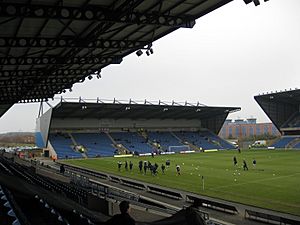
Since 2001, Oxford United has played at the Kassam Stadium. This stadium has seats for 12,500 fans. It is unusual because it only has three stands, not four. When it was first planned, it was meant to hold 16,000 people. But the club was in a lower league when it opened, so a smaller size was enough.
The record attendance at the Kassam Stadium for a football match is 12,243. This happened in 2006 during a game against Leyton Orient. The stadium has also hosted rugby matches, international football games, and music concerts.
In 2021, the club started looking for a new stadium site. They wanted to build an 18,000-seat stadium with other facilities. In January 2023, the local council agreed to discuss plans for a new stadium at a site called "the Triangle" in Kidlington.
In February 2024, Oxford United showed plans for a new "all-electric" 16,000-seat stadium. It would be near Oxford Parkway railway station and cost up to £150 million. The club hopes to open it in 2026. However, a decision on the plans was delayed until early 2025. This means the club might need a temporary home after their lease at the Kassam Stadium ends. In May 2025, a short extension was agreed to allow them to play at the Kassam Stadium until 2028, if the new stadium plans are approved.
Fan Support
Oxford United has several fan groups. One is OxVox, the Oxford United Supporters' Trust, which has over 400 members. It was formed in 2002 to help the club. The club also has a Juniors club for younger fans, offering special benefits.
Fans sing songs during home games, like "Yellow Submarine" with changed lyrics. Famous supporters include TV presenter Timmy Mallett and tennis player Tim Henman. The club's mascot is Ollie the Ox.
Oxford United was the best-supported club in the Conference National before Luton Town joined. A game between Oxford and Luton drew a crowd of 10,600, showing the strong fan passion. In 2009, fans set up a "12th man fund" to help the club buy new players. They raised over £40,000.
Club Rivalries
Oxford United's biggest rivalry is with Swindon Town. Games between them are called the A420 derby. This is because the A420 road connects the two cities, which are only 30 miles apart. They have played each other many times since 1962.
There is also a rivalry with Reading. This became stronger when Robert Maxwell wanted to merge the two clubs. Fans from both teams strongly opposed this idea. Oxford fans even protested on the pitch.
Other rivals include Wycombe Wanderers, Luton Town, and Northampton Town. There is less rivalry with Oxford City because they play in a lower league.
Players
First-team squad
|
|
Players on Loan
|
Reserve and Academy Players
|
|
Management and Staff
Current Coaching Staff
Club Leadership
| Position | Name |
|---|---|
| Chairman | |
| Owners | |
| Directors | |
| Chief Executive Officer | |
| Director of Football | |
| Football Adviser | |
| Secretary |
Club Managers
The first manager was Harry Thompson, hired in 1949. He led the team to win the Southern League title in 1953. Arthur Turner became manager in 1958. He was the longest-serving manager, staying for over ten years. Turner led Oxford to two Southern League titles, which helped them join the Football League. He also guided them to promotions in 1965 and 1968.
After Turner, several managers took charge. Jim Smith started his first time as manager in 1981. He led Oxford to the top league in English football with two promotions in 1984 and 1985. However, he left before the 1985–86 season.
The new manager, Maurice Evans, had immediate success. He won the 1986 League Cup. For the next 24 years, only Denis Smith managed to get the club promoted, which happened in 1996. Ramón Díaz from Argentina was the club's first non-British manager in 2004-2005.
Jim Smith returned as manager in 2006, the year Oxford United was relegated from the Football League. After he resigned, Darren Patterson took over in 2007. Patterson was replaced by Chris Wilder in 2008. Wilder led the club back into the Football League by winning the 2010 Conference play-off Final. He stayed for five years before leaving in 2014.
Gary Waddock was appointed head coach in March 2014 but was sacked in July. Michael Appleton then took over. In his three seasons, Appleton led the team to promotion to League One. He also reached two League Trophy finals, but lost both.
Pep Clotet became manager in 2017 but was sacked in January 2018. After a short period with a temporary manager, Karl Robinson was appointed in March 2018. Robinson helped the club stay in League One. He was sacked in February 2023. After a few temporary managers and Liam Manning, Des Buckingham became manager. He led the club to promotion to the Championship in 2024. Buckingham was sacked on December 15, 2024, and Gary Rowett became the new head coach.
Since becoming a professional club, Oxford United has had 26 full-time managers. Three of them (Jim Smith, Denis Smith, and Darren Patterson) have managed the club more than once.
Club Records and Statistics
The biggest home crowd for Oxford United was 22,750 fans. This happened at the Manor Ground on February 29, 1964, for an FA Cup match. The largest crowd at the Kassam Stadium was 12,243 in 2006.
Oxford's biggest win was 9–1 in the FA Cup against Dorchester Town in 1995. In the league, their biggest win was 7–0 against Barrow. Their biggest defeats were 7–0 losses to Sunderland in 1998 and Wigan Athletic in 2017.
The club's longest unbeaten run in the league was 20 matches in 1984. Their longest winning streak was nine games in the 2020–21 season.
John Shuker holds the record for playing the most league games, with 478 appearances between 1962 and 1977. John Aldridge scored the most league goals in one season, with 30 goals in 1984–85. Graham Atkinson holds the record for the most league goals overall (77) and most total goals (107).
The player with the most international games while at Oxford is Jim Magilton, who played 18 times for Northern Ireland. The most money Oxford has received for selling a player was about £3,000,000 for Kemar Roofe in 2016. The most they have paid for a player was £470,000 for Dean Windass in 1998, though the fee for Marvin Johnson in 2016 is thought to have been higher.
Oxford United is the only team in history to be promoted consecutively from Division Three to the First Division as champions.
Club Honours
League Titles
- Second Division (Level 2)
- Champions: 1984–85
- Third Division / Second Division / League One (Level 3)
- Champions: 1967–68, 1983–84
- Runners-up: 1995–96
- Play-off winners: 2024
- Fourth Division / League Two (Level 4)
- Runners-up: 2015–16
- Promoted: 1964–65
- Conference (Level 5)
- Play-off winners: 2010
- Southern League
- Champions: 1952–53, 1960–61, 1961–62
- Runners-up: 1953–54, 1959–60
Cup Wins
- League Cup
- Winners: 1985–86
- Football League Trophy / EFL Trophy
- Runners-up: 2015–16, 2016–17
- Southern League Cup
- Winners: 1952–53, 1953–54
Source:
See also
 In Spanish: Oxford United Football Club para niños
In Spanish: Oxford United Football Club para niños


